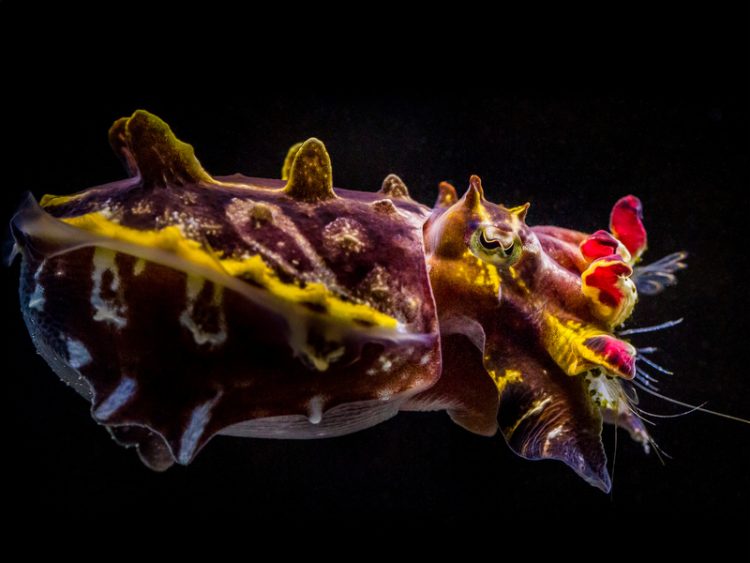Passing clouds in cuttlefish

The cuttlefish Metasepia tullbergi is not only extremely colourful, it can also generate colour waves traveling across its body. © Stephan Junek
Some cephalopods are masters of display: Not only can they adapt their skin colour to their immediate environment, thereby merging with the background, they can also produce propagating colour waves along their body.
These so-called ‘passing clouds’ can be observed in behavioural contexts such as hunting, swimming, mating, or even in animals resting under rocks. Their function, however, remains highly speculative. Researchers at the Max Planck Institute for Brain Research in Frankfurt, Germany, have identified a cuttlefish species in which these waves are so prevalent that their properties can be studied in the laboratory. Using simple behavioural methods, they have circumscribed their possible underlying causes to a relatively small set of neuronal circuits.
Cuttlefish, squid and octopuses have remarkable control over their skin pigmentation. Cephalopod skin contains elastic pigmented cells called chromatophores. An adult cuttlefish may contain several millions of them. The size of each chromatophore can be rapidly and individually altered by neural activation of radial muscles. If those muscles relax, their chromatophore shrinks.
If they contract, the chromatophore grows larger. One form of cephalopod pigmentation pattern is the passing cloud – a dark band that travels across the body of the animal. It can be superimposed on various static body patterns and textures. The passing cloud results from the coordinated activation of chromatophore arrays to generate one, or as in the present case, several simultaneous traveling waves of pigmentation.
The tropical cuttlefish Metasepia tullbergi proves to be a suitable model organism to investigate the possible neural mechanisms underlying these passing clouds. Using high-speed video cameras with 50 or 100 frames per second, the scientists from the Max Planck Institute for Brain Research observed that the mantle of Metasepia contains four regions of wave travel on each half of the body.
Each region supports a different propagation direction with the waves remaining within the boundaries of a given region. The animal then uses different combinations of such regions of wave travel to produce different displays.
The waves’ travelling speed can vary up to six-fold, but it is the same in all regions at a given time. The wavelength of each wave corresponds roughly to its length of travel, so that usually only one band is visible in each region at a time.
Those regions that are active simultaneously are also perfectly synchronized, meaning that the arrival times of two bands in their respective region match. In addition, the researchers observed that a travelling wave can even disappear and reappear in a different position, a phenomenon they call ‘blink’. It is a transient and local decrease in the intensity of the band, revealing on-going but invisible band propagation.
The results indicate that the passing clouds are not generated by the motoneurons in the mantle of the animal. Instead, neurons upstream of the chromatophore motoneurons are likely to form wave-pattern-generators. “In principle, three different types of neuronal circuits could be responsible for the periodic traveling waves in Metasepia tullbergi.
Based on our results we can exclude one of these types”, explains Gilles Laurent, Director of the Department of Neural Systems and Coding. The behavioural studies alone do not allow distinguishing between the two types of circuits. If future experiments, however, lend support to one type over the other, the present findings will help to specify the connectivity and biophysical properties of the circuit.
Contact
Prof. Gilles Laurent
Max Planck Institute for Brain Research, Frankfurt am Main
Phone: +49 69 850033-2001
Fax: +49 69 850033-2102
Media Contact
More Information:
http://www.mpg.de/8336540/colour-waves-cuttlefishAll latest news from the category: Life Sciences and Chemistry
Articles and reports from the Life Sciences and chemistry area deal with applied and basic research into modern biology, chemistry and human medicine.
Valuable information can be found on a range of life sciences fields including bacteriology, biochemistry, bionics, bioinformatics, biophysics, biotechnology, genetics, geobotany, human biology, marine biology, microbiology, molecular biology, cellular biology, zoology, bioinorganic chemistry, microchemistry and environmental chemistry.
Newest articles

Properties of new materials for microchips
… can now be measured well. Reseachers of Delft University of Technology demonstrated measuring performance properties of ultrathin silicon membranes. Making ever smaller and more powerful chips requires new ultrathin…

Floating solar’s potential
… to support sustainable development by addressing climate, water, and energy goals holistically. A new study published this week in Nature Energy raises the potential for floating solar photovoltaics (FPV)…

Skyrmions move at record speeds
… a step towards the computing of the future. An international research team led by scientists from the CNRS1 has discovered that the magnetic nanobubbles2 known as skyrmions can be…





















